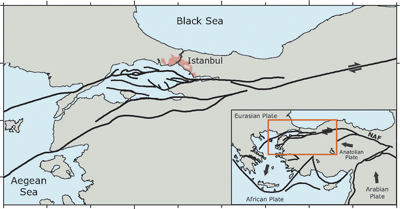
by Mary Caperton Morton Thursday, January 5, 2012

The North Anatolian Fault breaks into a complicated network of fault branches under the Marmara Sea, where it passes just 20 kilometers south of Istanbul, Turkey's largest city. Tobias Hergert
Since 1939, a progression of deadly earthquakes has been marching westward across Turkey’s North Anatolian Fault, stalking the mega-city Istanbul. Just over a decade ago, a magnitude-7.4 quake struck near Izmit, 100 kilometers east of Istanbul, killing 18,000 people. All signs point to Istanbul as the next likely target. But a new study suggests Turkey’s largest city may be struck by a series of moderate earthquakes, rather than one big event.
The North Anatolian Fault is a 1,500-kilometer-long east-west trending fault that runs across most of Turkey. Strain has been building up along the 150-kilometer-long stretch of the fault that lies just 20 kilometers south of Istanbul since the last large earthquake to strike the Marmara Sea in 1766. Because the North Anatolian strike-slip fault bears a strong geophysical resemblance to California’s San Andreas Fault system, the region has been studied extensively. But despite all the scrutiny, estimating the rate of slip along the western North Anatolian Fault has proven difficult due to the complexity of the fault system in the west, under the Marmara Sea.
Because the rate of slip along a fault controls the amount of strain accumulated and then released during an earthquake, calculating an accurate rate of slip is essential to understanding how large an event could strike a given region. Slip rates for the North Anatolian Fault have previously been reported as anywhere between 12 and 28 millimeters per year. To narrow this range, Tobias Hergert, a geophysicist at the University of Karlsruhe in Germany, and colleagues created new models using recent seismic studies of the complex fault branches under the Marmara Sea.
“Previous models were only able to take the main branch [of the North Anatolian Fault] into account,” Hergert says. “We were able to include many of the smaller fault strands that have only recently been mapped.” Their models, published in Nature Geoscience, indicate that the smaller faults are actually accommodating much of the fault’s movement. The North Anatolian Fault is therefore only slipping by between 12 and 17 millimeters per year, Hergert says.
The new model also indicated more variation in slip rates along sections of the main fault than had previously been noted. “Because of the variability in slip rates along the fault, we concluded that it’s more likely that two or three small to moderate events may fill the seismic gap” — earthquakes less than a magnitude of 7.0 — “rather than one large one,” he says.
But not everybody is ready to write off the North Anatolian Fault’s capability of producing a large earthquake. “I think the answer lies in the past,” says Tom Rockwell, a paleoseismologist at San Diego State University in California who was not involved in the new study. “This region had large earthquakes in 1063, 1509 and 1766, and I see no reason why another large event couldn’t strike this region again,” he says.
Either way, Istanbul is by no means in the clear. Hergert and colleagues are quick to point out that even a moderate event of a magnitude of 7.0 could do serious damage to Istanbul, a populous city with many high rises and somewhat lax building codes. Rockwell agrees: “Whether Istanbul is struck by a magnitude 7 or 7.6, the damage is likely to be substantial.”\
© 2008-2021. All rights reserved. Any copying, redistribution or retransmission of any of the contents of this service without the expressed written permission of the American Geosciences Institute is expressly prohibited. Click here for all copyright requests.